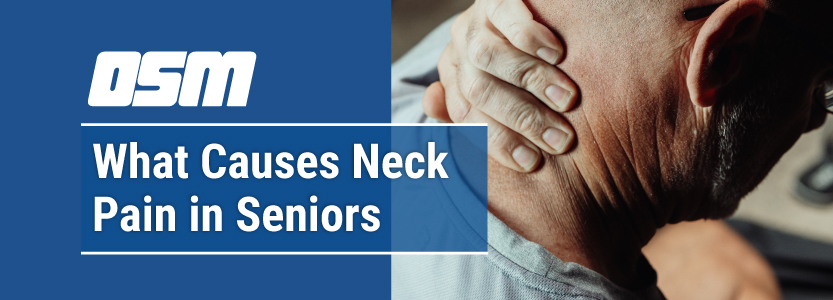What Causes Neck Pain in Seniors?
Article featured on MedicineNet
Understanding the anatomy of the neck
Most people will have neck pain at some point. Injuries and certain illnesses can cause neck pain, but the most common cause is holding your neck in the same position for a long time. More serious symptoms can come from changes in the upper spine that come with aging. These changes often cause neck pain in seniors.
The neck contains seven bones called vertebrae that enclose the spinal cord. Other nerves branch out from the spinal cord. Disks between the bones act as shock absorbers. They have a tough outer coating and a jellylike interior. Muscles and ligaments bind the vertebrae together, providing both flexibility and support. Injury to any of these parts can cause neck pain.
Pressure on the spinal cord in the neck can be serious because most of the nerves that serve the body pass through the neck. Problems in the neck can cause pain, numbness, and weakness in the arms, chest, abdomen, or legs. Many organs rely on the nerves that pass through the neck for proper function.
What are the effects of neck pain?
Neck pain can affect your employment, social life, and personal relationships. When neck pain causes you to avoid certain activities, both your physical and mental health can suffer. Sometimes, it may seem that doctors and family members don’t believe that you are having real neck pain as you age. You may become angry, anxious, or depressed.
Neck pain can get worse through the pain cycle:
- Pain causes you to reduce movement.
- Reduced movement causes the muscles to get weaker.
- Weaker muscles get tired faster.
- Tired muscles result in increased pain.
How is neck pain diagnosed?
A muscle spasm or sprain can cause neck pain. Doctors can often diagnose this type of neck pain with a physical examination. Doctors use X-rays to diagnose neck pain caused by arthritis. If your symptoms suggest nerve problems, doctors will often use magnetic resonance imaging (MRI) or computed tomography (CT) to diagnose it.
What causes muscle pain in the neck?
Poor posture that results in muscle strain is a common cause of neck pain. You can prevent this type of neck pain by taking these steps:
- Keep your neck in alignment by not using too many pillows when you sleep.
- During the day, don’t stay in the same position for too long. A fitness tracker can remind you to get up and move.
- Be aware of your position, especially when using electronics. Avoid text neck. Change your computer setup to make it more ergonomic.
- If you wear glasses, be sure your prescription is correct so that you’re not craning your neck to see over your glasses or through a certain section of your lens.
- Don’t take on more than you can handle. Get help for big jobs that involve the arms, shoulders, and neck.
You can treat muscular pain in the neck with over-the-counter pain relievers and with heat and cold. You may have to modify your activities for a while, but you should try to stay active.
What are the other causes of neck pain?
Many older people have osteoarthritis, which can cause neck pain. The joints of the neck are subject to wear and tear just like other joints in the body. In conjunction with this, aging can cause these three conditions:
Cervical spondylosis. This term covers the changes that occur in the neck with aging. Cartilage may wear away. Disks can become thin and dry so they don’t cushion the bones. Your body may try to compensate by growing extra bone in the form of bone spurs. These changes in the neck may cause pain from pinched nerves.
Cervical spinal stenosis. Changes in the neck cause the spinal canal to narrow, putting pressure on the spinal cord and other nerves. Besides neck pain, people with spinal stenosis often have symptoms in their extremities. They may have numbness, weakness, or poor coordination in the arms, legs, feet, and hands.
Disk problems. Changes in the disks between the vertebrae can cause neck pain. Disks that are squeezed between two of the bones in the neck can rupture. The disk may bulge out through the tear, a condition called herniated disk. Damaged disks can press on the nerves and even compress the spinal cord.
How is neck pain treated?
Treatments for neck pain can be nonsurgical or surgical.
Nonsurgical treatments include:
- Steroids
- Injections of various types
- Physical therapy
- Manipulation of the neck
- Acupuncture
- Cervical collar
- Cervical traction
Doctors may suggest surgery, though, if more conservative treatments don’t help or if symptoms get worse. To be a candidate for surgery, you must be in good health.
The Orthopedic & Sports Medicine Center of Oregon is an award-winning, board-certified orthopedic group located in downtown Portland Oregon. We utilize both surgical and nonsurgical means to treat musculoskeletal trauma, spine diseases, foot and ankle conditions, sports injuries, degenerative diseases, infections, tumors and congenital disorders.
Our mission is to return our patients back to pain-free mobility and full strength as quickly and painlessly as possible using both surgical and non-surgical orthopedic procedures.
Our expert physicians provide leading-edge, comprehensive care in the diagnosis and treatment of orthopedic conditions, including total joint replacement and sports medicine. We apply the latest state-of-the-art techniques in order to return our patients to their active lifestyle.
If you’re looking for compassionate, expert orthopedic and podiatric surgeons in Portland Oregon, contact OSM today.
Phone:
Address
17355 Lower Boones Ferry Rd Suite 100A
Lake Oswego, OR 97035
Hours
Monday–Friday
8:00am – 4:30pm

